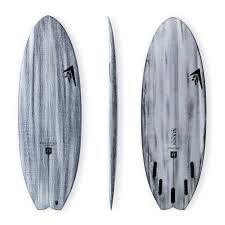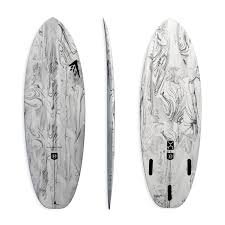Finding the Best Surfboard for Small Waves (and 6 of Our Favorites)
If you live somewhere like I do where small waves are the norm, a small-wave surfboard is a must have in your quiver. Sure, we all wait for those beautiful, glassy offshore waves that pump. But reality doesn’t always cooperate with my dreams.
We’ll cover a bit about what makes a surfboard ideal for small waves, as well as a few of my favorite boards for catching them. I have quite a few of the boards mentioned, and have personally tried the others, so check it out!
What Makes a Surfboard Good for Small Waves
First, let’s consider what makes a surfboard ideal for the small, weak days. Unless you’re pretty advanced, a shortboard will be tough on those days as the lack of volume and more perfomance-based shape will make it hard to catch waves.
Flat Rocker
First, a lot of small wave shortboards will have a relatively wide, flat rocker. This is especially true through the middle and tail. Boards like the Sweet Potato are remarkably flat in fact. This helps what is known as planing speed. This is essentially the rate of acceleration. With a flat rocker, you can accelerate more rapidly into the wave to catch the smaller waves that lack force.
Higher Volume
For smaller days, you’ll likely want to up your volume from your preferred good-wave board. The increase in volume comes at the cost of maneuverability, but will help you catch way more waves. For this reason, many grovelers have significantly more volume than a similar length board that is more of a performance board. For example, I ride a 5’10” board on good days that comes in around 37L. When the waves are smaller and weaker, I either take my Sweet Potato (51L) or my Moe (52.9L).
Volume Farther Forward
On small-wave surfboards, the volume will be slightly farther forward than a performance shortboard. This volume closer to the chest helps with planing speed, allowing you to catch more waves.
Length
And finally, there’s length. Longboards are a great way to catch a bunch of small waves. Although it may not be everyone’s preferred style of surfing, it’s a fun way to catch a lot of waves. A longboard that is 9+ feet will have more volume and the length helps you catch as many waves as possible.
Best Surfboards for Small Waves
Firewire Sweet Potato from the Firewire shop
Firewire Sweet Potato
People seem to either love or hate the Sweet Potato. The boards have come a long way since first introduced in 2012, and the newer shapes are much better than the original in my opinion. A true groveler, the Sweet Potato is packed with volume. It’s probably one of the thickest board you’ll ever ride, but it absolutely rocks in small and mushy waves. With the flat rocker and width it has, it can catch some impressively small and weak waves. When the waves get bigger it will lose its hold due to the flat rocker, but it really excels in knee to chest high weak waves.
LostPuddle Jumper from Catalyst Shop
Lost Puddle Jumper HP
The Lost Puddle Jumper was my first groveler I ever had, and I absolutely loved it. It has a nice concave to it, a relatively flat rocker in the middle, and can catch small waves super easily. It might not get quite the smallest of waves like the Sweet Potato, but it’s much more responsive in my opinion. If you’re looking for a board you can take out in 1-3 foot mush or 6 foot waves, the Puddle Jumper should definitely be on your list.
Firewire Machadocado from KS Boardriders
Firewire Machadocado
The Machadocado is a more recent release from Firewire and Rob Machado. I’d call it somewhere between the Sweet Potato and the Seaside. It has the extra width of the Sweet Potato to handle the smaller waves with ease, but a thinner foil to help hold turns in larger waves. I’ve only ever surfed one once, but really liked it. It’s more responsive and less skatey than the Sweet Potato with slightly lesser volume.
Firewire Seaside from Fireside shop
Firewire Seaside
The Firewire Seaside is an evolution of a previous board from Firewire, the Go Fish. The idea behind the Seaside was to create something that excels in small waves, but is a little more high performance. It has a smaller tail and more rocker to give it a bit more of a performance feel. It’s a popular board for a reason. It can handle head-high waves, but really works best in smaller, flatter waves. The people I know who have these boards use them as their daily driver in almost any conditions.
HI Moe from Subtotal Distribution
Harley Ingleby Moe
The Harley Ingleby Moe is a mid-length surfboard that works super well on small waves. Mid-lengths are a surfboard shape that can work well in small waves. They aren’t as responsive as a performance short board, but they are more responsive than a longboard. I have an HI Moe, and it’s straight up the board I use more than anything. It can catch impressively tiny wave with it’s volume (mine is 7’4” and 52.9L). It is a great board in my opinion for people transitioning from longer boards into shorter boards, or someone perhaps making the jump from a foamie after appropriate time. It also handles OH waves fairly well for what it’s worth.
Longboards
I’m not going to list a specific longboard here, but just the general shape. If you have small waves, a longboard may be the right fit. We also have a longboard and I take it out on the smaller, mushier days. It’s a different style of riding, and I often have more mellow and relaxed days on it. The volume and size of a longboard makes small waves catchable without a ton of effort. You won’t get the same responsiveness as a shortboard or groveler, but you will catch plenty of waves. With the extra time on the wave you’ll get, we think a longboard is a great beginner’s surfboard.











